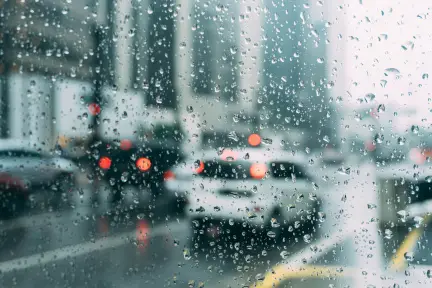
Imagine the following situation: your car is racing at high speed into a sudden downpour. The water sprays loudly into the wheel arches and up to the side. Your car begins to roll uncontrollably. How do you keep track of this terrifying moment?
In this article, we will share tips about driving in the rain. You will learn how to act correctly in an emergency and how to minimize your risk of aquaplaning.
Driving in the rain: What to consider before your journey
Think for a moment about whether it is necessary to leave immediately - or whether you can postpone your start until the worst of the rain is over.
- There is no other way, you have to leave immediately? Then be sure to check your wiper blades beforehand. All windshield wipers - both front and rear - should be in good working order. Otherwise, you should change them immediately.
- Fill up with fuel. Heavy rain increases the likelihood of vehicles breaking down or accidents. You may be stuck in a traffic jam while the wipers and heating are running at full speed and the headlights are on. Then the last thing you want is a blinking fuel gauge.
- Familiarize yourself with the settings for the heating and ventilation system or the air conditioning system in your car. You may want to quickly de-fog your windows.
- Pay attention to announcements on the radio. Find out about possible road closures, accidents, or flooding on your route and work out a bypass route if necessary.
- Charge your mobile phone so that you can stop and report if you are late.
Driving in heavy rain: Safety tips
Pay attention to your speed and keep a generous distance from the vehicle in front - so that there are at least 4 s between the car in front of you. Even with winter tires, your braking distance is longer compared to a dry road. If someone drives you too close, it is best to let them pass you. It is better to have the vehicles in front of you than behind you.
Be prepared for splashing water from trucks or fast-moving cars, which can severely obstruct your view for a short time. On the other hand, be aware of your own splash of water too, and don't drive through puddles at high speed when there are pedestrians or cyclists nearby.
When it rains, breakdowns are more common as moisture can cause electronics and engine problems. If you should get stranded, keep the hood closed to prevent further damage. Also, do not attempt to restart the engine if it has failed after driving through deep water.
If you drive through a puddle, under certain conditions the wheels can float, known as aquaplaning. Your tires lose contact with the road and the steering can suddenly feel unusually light. In such a situation, take off the gas immediately and let your car slow down until you feel in control again. Until then, do not brake, but instead, disengage the clutch and avoid steering if possible.
Once contact with the road is restored, you should gently tap the brake pedal to generate some frictional heat in the brake. In this way, you allow moisture to evaporate that may have accumulated there and impair the braking effect.
Same articles

Understanding Vehicle Inspection and Verification Services: Why They Matter for Every Driver
GuidesVehicle inspection and verification services are an essential but often overlooked part of keeping roads safe and cars legally compliant. Most people only think about inspections when it’s...
KLIFEX Brand Overview: High-Quality Automotive Repair Kits for Affordable Repairs
GuidesThe automotive aftermarket has long needed solutions that combine reliability, durability, and affordability. Many car enthusiasts and services are looking for a way...
Fast, Reliable Vehicle Emissions & Inspection Services Made Simple
GuidesFast, reliable emissions and inspection services are essential for keeping vehicles road-ready, compliant with environmental regulations, and safe for daily driving. If you’re looking for quick...

